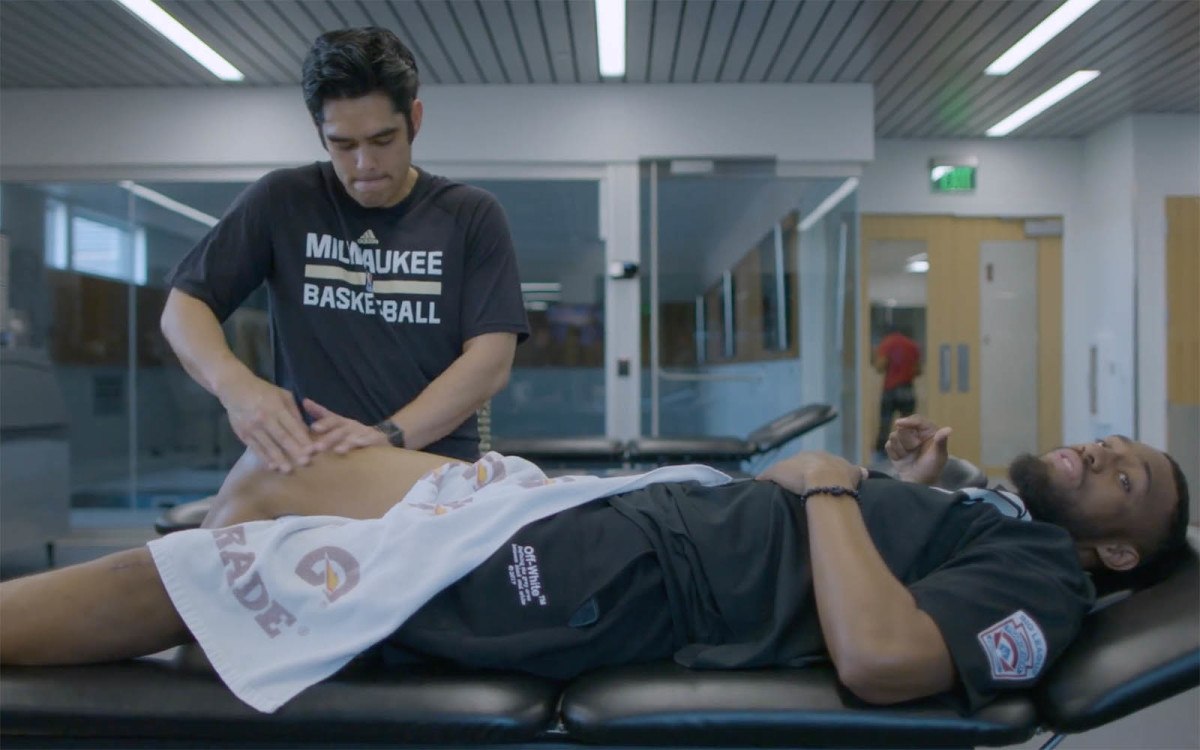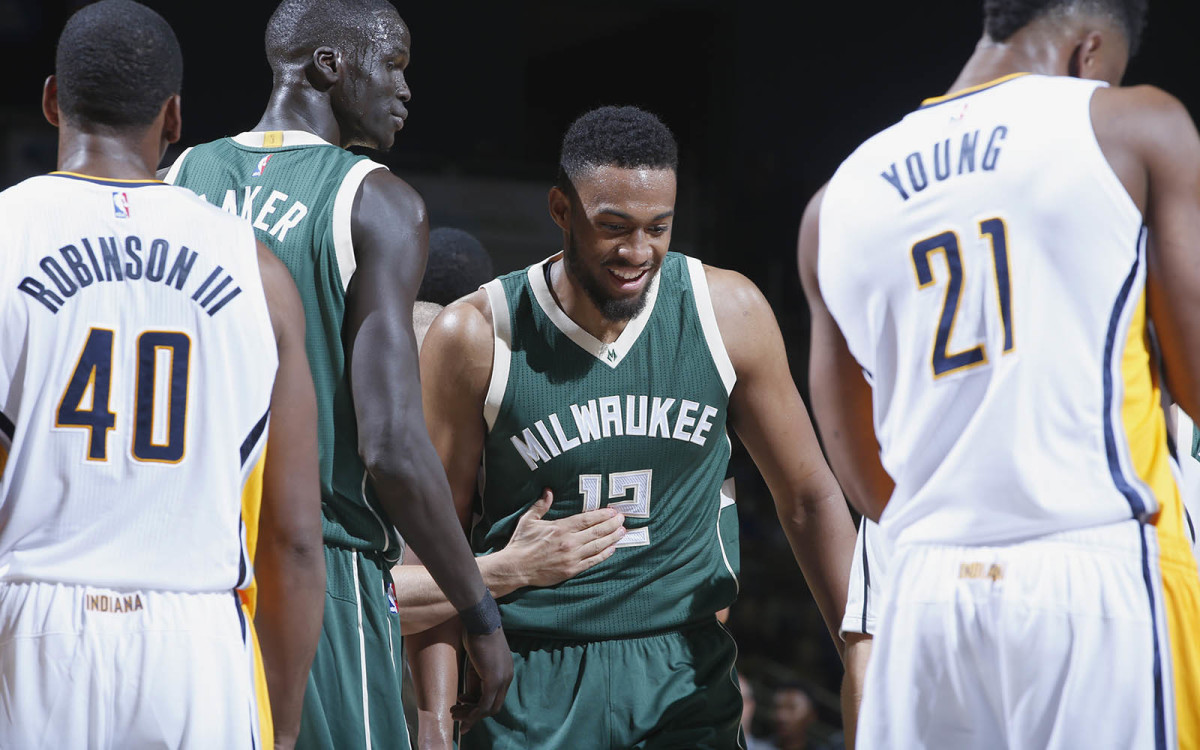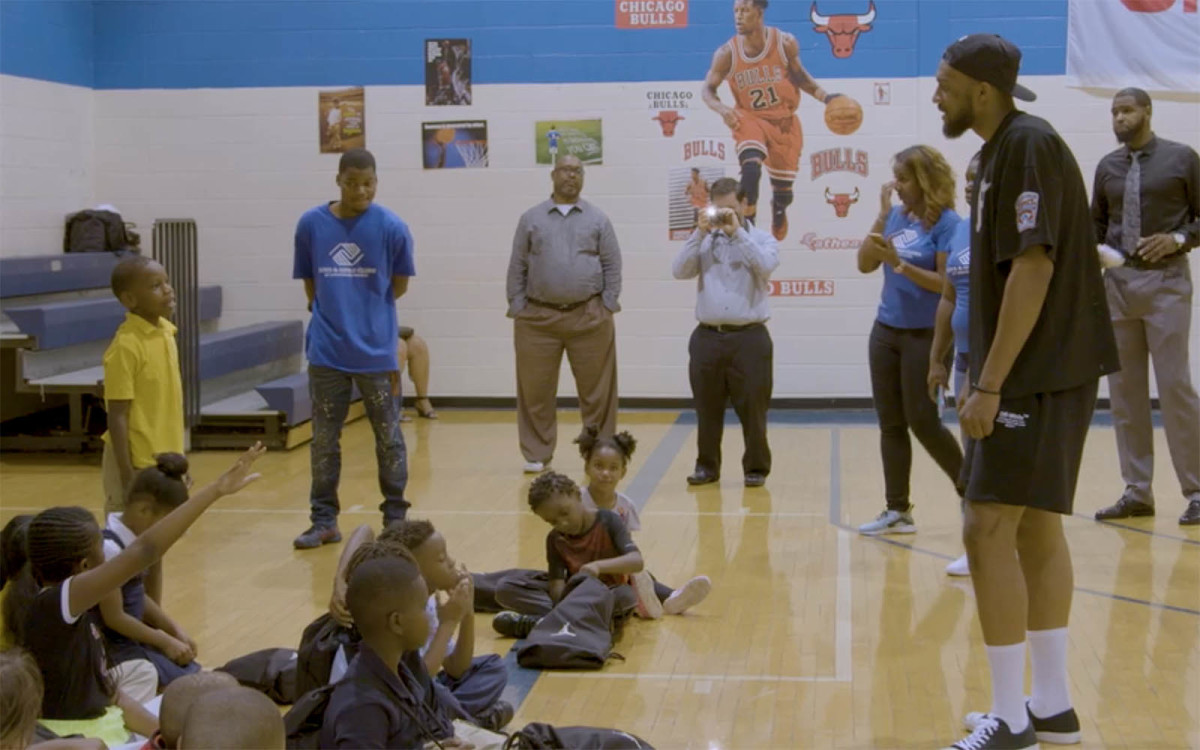The Scars That Shape Jabari Parker

Jabari Parker’s left knee reads like a distorted barcode. A long streak of fibrous tissue stretches straight down the middle, left behind from the first time Parker’s ACL gave out. He was attacking the Suns in the open floor when a tragically ordinary step betrayed him. Nearly a year passed before Parker could return to game action. Other raised, darkened lines track parallel to that first scar but never meet it. They are distinct, born of an entirely different dribble-drive Parker made against the Heat last season. After taking a long stride with that same left leg, Parker folded to the floor, clutching at the familiar point of disconnection. The same ACL had torn again. His season ended on the baseline.
Another surgery tattooed Parker’s predicament into reality. There are stripes on each side of his knee that serve to frame it. Across the front, staggered lines remind that a second reconstruction is rarely as simple as the first. Each mark has its own shade and texture. Two, just below the kneecap, are small and circular, as if left behind by punctures. This is not the knee of a 22-year-old, but then again, so much about Parker belies his age. “I see beauty in my scars,” Parker said, months into yet another extended rehab. “They tell my story.”
Now in his fourth NBA season, Parker is already short on contextual parallels. An ACL tear is unfortunately common enough among pro basketball players; Chicago’s Zach LaVine and Phoenix’s Brandon Knight have suffered the same injury in the last nine months alone. To tear the same ACL twice, however, offers Parker a lamentable distinction. There are but a few of these cases on record in the NBA, most involving long-time veterans and none particularly encouraging. Repeat ligament damage has a way of ending careers. Parker’s is just getting started. His rookie season lasted only 25 games. Once he returned, Parker had but a year and a half to reacclimate before all his progress was taken out from under him. “I don't feel like I got off my feet yet,” Parker said. In the 51 games he was able to play last season, Parker averaged better than 20 points and six rebounds per game.
Basketball’s comeback narratives don’t exactly resonate in these exceptional circumstances. “I’m on a race on my own,” Parker said, laying prone across a training table. This sort of extended rehabilitation is monotonous work—the kind that strips away the game itself. Treatment and drilling take center stage as basketball is distilled to its most basic components. If Parker wants to work on a certain move, it must be extracted entirely from the game setting for practice in quarantine. Full contact five-on-five is not yet an option. So basketball’s natural rhythms are displaced by pure repetition, all the better to retrain muscles that are woefully out of practice.

While his teammates run an open scrimmage at the Bucks' practice facility, Parker announces his presence from the adjacent weight room with blaring hip-hop. Dr. Dre’s “Let Me Ride”—a track released three years before Parker was born—bounces off the walls. Working toward stability is a daily goal. Parker is healthy enough to push off with his injured knee on a drive, but not quite so healthy as to trust in that bearing completely. The body has to be reminded of all it can weather. For the two times that Parker’s knee buckled, there are thousands where it flexed and braced as intended. Every workout carries the added value of putting more distance between the injury and the present. Bucks strength and conditioning coach Suki Hobson oversees as Parker pumps his legs on a trampoline platform, dancing through steps at every angle. The process then repeats to isolate each leg. Parker lifts his injured knee and fires through reps on his right. He takes a deep breath and switches, pushing the leg responsible for his troubles deep into the trampoline on every impact. Then he stumbles. There can be no mistaking which leg is stronger.
Everywhere Parker goes, the question follows. When are you coming back? It pops up with the fan on the street, the genius at the Apple store, and the kids at the Boys and Girls Club. They all mean well, but Parker dodges, sidestepping the question like a politician. Jabari has been here before. Even the smallest of conversations play into the expectations game, one that any athlete scheduled to miss an entire year of action cannot hope to win. Parker opts not to try. In public, his every word breeds caution. “I want to wait as long as I can just so I know where I am and I don't have to rush nothing,” he said. In private, Parker punctuates the end of his workout with a power dunk off a single step, a suggestion that he may be closer than he lets on.
In the meantime, the only satisfaction to be had draws from the weight of this kind of undertaking. For Parker to go where he’d like as a basketball player would demand the unprecedented. “The things that I'm going through,” Parker said, “is creating some type of greatness.” To earn it, Parker has dedicated himself to his regimen. There is no guarantee that comes with frequenting the cold tub or making targeted stretching a force of habit. Parker still has to fight through every uphill step with miles upon miles left to go. He may yet fail. But Parker wonders: “What better way to learn things than for them to be hard?”
“This type of rehab, this type of journey that I'm living through right now is necessary for my development,” he added. “It's trying to teach me that it can all be taken in an instant.”
Injury tends to walk arm in arm with sobering realization. One moment you could be the No. 2 pick in the draft, anointed to carry the aspirations of an entire franchise. The next, a mere observer to that team’s fate in the playoffs. When Parker first tore his ACL in 2015, his instinct was to withdraw. “I was by myself a lot,” he said. Parker was 19. This was his first year out of college and his first in a new city. Adapting to the league had been his most pressing concern, and overnight he was robbed of it, made to connect with the game in an entirely different way. His schedule was wiped clean, leaving him with nothing but time to dwell on all he had lost. “I've been in a very dark place,” Parker said.
This time is different. Parker has effectively moved back in with his mom, Lola, over the past few months of his rehab. Every morning he wakes up in a re-creation of his childhood bedroom—transported, poster for poster and Beanie Baby for Beanie Baby, from the south side of Chicago to the Milwaukee suburbs. Essential oils waft throughout the house, along with the smell of breakfast. The eggs are on the griddle before Jabari can shout down to the kitchen, the pro athlete playing the part of a teenager on summer vacation. Something about being back at home turns us all into our former selves. By the time Jabari makes his way downstairs, breakfast sandwiches are made and wrapped in foil. Lola will pack him a plastic bag full of grapes for the road, the same kind that a high school freshman might fish out of their sack lunch.
When he has time, Jabari will post up on the couch with his breakfast to browse YouTube. He begins to type: C…H…A…R…L…E…S. Parker arrows over to the auto-complete field to find Charles Barkley, but winds up over-scrolling and selects Charles Manson by mistake. This breakfast is about to take a turn. “Not him,” Parker mutters. “I don’t even know who that is.” After a merciful course correct, Jabari arrives at his intended destination. Barkley barrels past defenders, dunking everything in sight.
“I like when guys changed the game not only through their play, but the attitude of it,” Parker says. “Like Magic's leadership. Charles Barkley's attitude.” On the screen, Barkley wipes out an opponent’s shot attempt before standing over him, jeering. “He had an edge to him because obviously he wasn't the tallest guy on the court, but he made himself known through his demeanor. I like that. I'm just trying to take some of those things away while also trying to find who I am through it all.”

The search extends well beyond basketball. The Parkers know the man Jabari has become, but they also know the big kid who never left. Lola and Tilah, Jabari’s sister, once came home from the store to find the lights off and “Thriller” blasting through the TV. Jabari was dancing along, unaware of his audience. He screamed when he saw them. “I was shook!” Parker confesses. Perhaps it was karmic retribution for all the times the 6’8’’ forward has hidden around corners and in closets to scare his siblings. (Add “stealth” to the scouting report.)
This is the whole Jabari Parker, as world-weary as he is youthful. In between dance numbers, he speaks with poise in advocacy. “We all came here to build, not destroy,” Parker recently told the crowd at an anti-racism rally in Salt Lake City. The same individual can take a stand against Trumpian politics (“He’s attacked everything that I am and believe,” Parker said last November) and also cherish the stuffed chameleons he once pulled from a Happy Meal. These ideas are not at odds; they are all-encompassing. The transition from shooting the breeze on a podcast into casual mention of reparations feels effortless because it is. No costume change is necessary for someone of Parker’s lived experience and thoughtful consideration.
“I really don't believe in the system itself,” Parker said. “Like welfare, public aid, the public school system. I don't really believe that it's the best that it can be. It's always inside-out.” It frustrates Parker that funds designated to help low-income communities in Chicago were instead funneled into spiffing up Navy Pier. It bothers him that as inner-city public schools close, so little regard is paid to how students will actually travel to their sometimes-distant charter school replacements. The “stick to sports” ethos has always been a farce, but the way Parker speaks and acts leaves it nakedly so. Why would anyone want to stand in the way of a 22-year-old millionaire’s sense of civic responsibility?
It is a gift that Parker, at his age, naturally searches for the connections between people and things. He sees himself as part of something—Chicago, Milwaukee, the Bucks organization, the Mormon church, the black community. There are bonds everywhere that transcend him alone, down to that between athlete and fan. Parker hears the anger that swirls through sports fandom. “At any point in time,” Parker observed, “they can just burst into flames.” He notices when his injury history is wielded against him as if it were a personal failing. All he wants is to carry the weight.
“You process the criticism in a way that you take the burden off of other people,” Parker said. “That's what sports is, in general… It's just taking a load off of them. If they've got to express their feelings in a negative way just for them to feel better about themselves or their day, then so be it.”
Basketball has taken Parker from one of America’s most segregated cities to another. Chicago, redlined into long-lasting division, is the textbook example with a national spotlight. Milwaukee is more quietly—but severely—divided. The rule of law may be less overtly hostile than in the heyday of America’s housing discrimination, but the city itself remains segmented on racial boundaries. The bridge connecting black and white neighborhoods was once known as “Milwaukee’s Mason-Dixon line.” Parker has tried to understand both cities without letting entrenched, complex problems stand in the way of actionable good. Not only are Parker’s summer basketball camps free, but he has bused in kids from across the city to ensure diversity.
When he chooses to speak out on a particular issue, his voice comes from a place of social responsibility. Nothing about Parker suggests he is a political animal—merely a conscious person aware of the spiraling world around him. It should not be controversial to want better of our institutions, to oppose bigotry, or to hope for opportunity. Yet the times we live in have turned Parker’s empathy into a kind of contention. He wishes he didn’t have to be this vocal. No person as reserved as Parker takes to the soapbox without purpose.

Youth causes call to him. On his visits with kids around Milwaukee, Parker thinks back to the way his own hometown team kept the community at a remove. “The Bulls players didn't care,” he said. When he pays his taxes, he remembers the free lunches that got him through school. There are reflections of a young Jabari everywhere around him—what he had growing up and what he didn’t.
Parker is both the big-time endorser of Jordan Brand and the kid who could never afford to wear the shoes. It wasn’t just that they were expensive; in Parker’s neighborhood, wearing Jordans made you a target. A status symbol was wrapped in real danger. “All the drug dealers had them, though,” he noted. These were, in many cases, intelligent young people short on options. “They knew that after high school, that was the last stop,” Parker said. “Nobody was gonna be able to get them to college.” Some kids make it out of those neighborhoods. Some wear Jordans.
This is the world Parker comes from. Even now—with a career to occupy him, an injury to concern him, and an upcoming contract to consider—he feels a responsibility to help change it. “It doesn't matter how many baskets I score,” Parker said. “It doesn't matter how much money I get [over] the length of my career. What matters is the impact.”
When it came time for Christian Parker to name his first-born son, he turned to his younger brother. Jabari didn’t blink. Immediately he suggested the name of a proud, passionate leader who gave up everything for the sake of change. It was the name of a scholar who did so much reading in the dark he was forced to wear glasses. It was a name of confidence—one unusual enough that his nephew would have to assert it, over and over, throughout his life. His name is Shabazz. “I named him after my idol, Malcolm X,” Parker said. “As he gets older, he'll find out what his name means.”
Parker can relive the entire journey of Malcolm X, but what grabs him most is the memory of a man who never stopped searching. Part of what makes him such a polarizing figure is how continuously he evolved. Malcolm X was a different person when he was released from prison than when he entered it. His worldview changed from the time he joined the Nation of Islam to when he left. Long-held philosophies shifted and turned until the day of his murder, emboldened by equal resolve. Here is proof that a man can be made and remade.
“No matter where you are in life,” Parker said, “you can always transform.”
